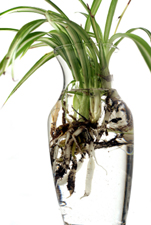Spider Plants – Exotic Cascading Foliage
Spider Plants (also known as Airplane Plants and Ribbon Plants) are hardy, versatile plants that can be displayed outside in containers, or planted as ground cover. They are popular houseplants because they are easy to care for and propagate.
These plants can be displayed on a pedestal in an entryway, or planted in a hanging basket to show off their cascading plantlets.
The curved, strap-shaped leaves of the Chlorophytum comosum are 8 to 16 inches in length, and are solid green in color, or green with a white or yellow stripe running down the center. Some variegated spider plant varieties are green at the center, with white at the edges.
The small white, star-shaped flowers appear at the end of arching shoots, which later develop plantlets at the tip. This plant can grow 2 to 4 feet in diameter, and one foot in height.
Spider Plant Care
Ribbon Plants will thrive with minimal care and attention. They are a versatile plant that is easy
to care for, that will grow indoors as a houseplant, or outdoors in a
container or as ground cover. Follow these tips to grow and care for
spider plants:
versatile plant that is easy
to care for, that will grow indoors as a houseplant, or outdoors in a
container or as ground cover. Follow these tips to grow and care for
spider plants: Watering
During spring and summer months, keep soil moist without over saturating. During fall and winter months, since water will not evaporate rapidly, you can reduce the frequency of watering.
When watering container plants, water should run out of the drainage hole at the bottom of the container. Do not allow this plant to sit in standing water – this could cause root rot. Flouridated water can cause the tips of the leaves to burn. If this becomes a problem, consider collecting rain water or buying distilled water from the store.
Light & Temperature
Chlorophytum comosum thrive in partial to full shade. If leaves begin to turn brown, the plant could be receiving too much sun (this could also be a sign of underwatering). Try moving the plant to a shadier location.
Ideal temperature is 65 to 80° F. If indoors, avoid placing plant near hot or cold drafts that could cause extreme fluctuations in temperature.
Fertilizer
Fertilize these plants with a soluble houseplant fertilizer. Fertilize every two to three months. Refer to the manufacturer's recommendations to determine the appropriate amount of fertilizer to use.
Repotting
If your spider plant outgrows its container, it will become root bound and might damage the container. You have two choices: 1) You can repot the entire plant in a larger container, or 2) Divide the plant, and replant each section in separate containers.
How to Propagate Ribbon Plants
This plant is easily propagated any time of the year. You can propagate this plant using the
following methods:
propagate this plant using the
following methods:
- Divide the parent plant. Repot the divided sections into
containers, or
plant in the ground.
- Cut off one of the plantlets growing at the end of the
arching shoots.
Place it in a glass of water. When the plantlet has grown a healthy
root system, it can be potted or planted in the ground.
- Leave plantlet attached to the parent plant. Place a container filled with commercial potting soil next to the parent plant. Place the plantlet in the pot, and hold it in place with a hairpin or bent paperclip. In approximately six week, roots will become established. When roots are well established, the plantlet can be cut from the stem.





